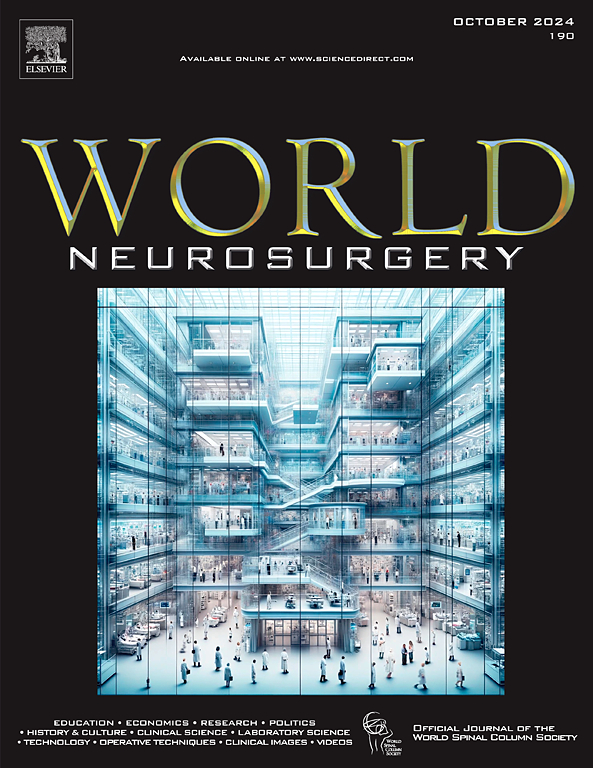Treatment Outcomes of Epidural Blood Patch Guided by a Novel Overflow Leak Test with Computed Tomography Myelography in Patients with Intracranial Hypotension: A Case Series
IF 1.9
4区 医学
Q3 CLINICAL NEUROLOGY
引用次数: 0
Abstract
Objective
To describe the treatment outcomes of epidural blood patch (EBP) guided by a novel overflow leak test (OLT) combined with computed tomography myelography (CTM) in patients with intracranial hypotension, with focus on consistency and discrepancy between CTM and OLT findings.
Methods
CTM followed by OLT was performed in 18 adults with a cerebrospinal fluid pressure of ≤60 mmH2O. Patients were categorized according to consistency or discrepancy between CTM and OLT findings: Group A, matching leak signals in CTM and OLT; Group B, leak signals detected by OLT only; Group C, discrepancy in leak signal sites between CTM and OLT; Group D, no leak signal detected by both CTM and OLT. EBPs were applied according to the treatment policy, and associations between the radiological categorization and treatment outcomes were determined. Thereafter, using CT and magnetic resonance imaging phantoms, we investigated the minimal amount of injected agent leaking from the lumbar puncture site visible, which could result in a false-positive signal in CTM and OLT.
Results
Complete recovery following EBP was achieved for 13 (72%) patients; these included 50%, 82%, 100%, and 0% patients in Groups A, B, C, and D, respectively. In CT myelography phantoms, even 1 μL of contrast agent produced positive findings, whereas OLT phantoms required a minimum of 1000 μL.
Conclusions
These results suggest the potential additive diagnostic value of OLT when performed with CTM. The discrepancy in radiological findings could be partly explained by susceptibility to the contrast agent leaking from the lumbar puncture site.
一种新型的计算机断层脊髓造影溢漏试验指导下的硬膜外血贴片治疗颅内低血压患者的疗效:一个病例系列。
目的:探讨新型溢漏试验(OLT)联合ct脊髓造影(CTM)指导下硬膜外补血(EBP)治疗颅内低血压患者的效果,重点探讨CTM与OLT结果的一致性和差异。方法:对18例脑脊液压力≤60 mmH2O的成人进行CTM + OLT治疗。根据CTM和OLT结果的一致性或不一致性对患者进行分类:A组,CTM和OLT的泄漏信号匹配;B组,仅通过OLT检测泄漏信号;C组,CTM与OLT泄漏信号部位差异;D组,CTM和OLT均未检测到泄漏信号。根据治疗政策应用ebp,并确定放射学分类与治疗结果之间的关系。此后,我们利用CT和磁共振成像成像幻象,研究了从可见的腰椎穿刺部位渗漏的最小注射剂量,这可能导致CTM和OLT的假阳性信号。结果:13例(72%)患者EBP术后完全恢复;A组、B组、C组和D组分别为50%、82%、100%和0%。在CT脊髓显影中,即使是1 μL的造影剂也能产生阳性结果,而OLT显影至少需要1000 μL。结论:这些结果提示OLT与CTM联合应用时具有潜在的附加诊断价值。放射学表现的差异可以部分解释为对腰椎穿刺部位的造影剂泄漏的敏感性。
本文章由计算机程序翻译,如有差异,请以英文原文为准。
求助全文
约1分钟内获得全文
求助全文
来源期刊

World neurosurgery
CLINICAL NEUROLOGY-SURGERY
CiteScore
3.90
自引率
15.00%
发文量
1765
审稿时长
47 days
期刊介绍:
World Neurosurgery has an open access mirror journal World Neurosurgery: X, sharing the same aims and scope, editorial team, submission system and rigorous peer review.
The journal''s mission is to:
-To provide a first-class international forum and a 2-way conduit for dialogue that is relevant to neurosurgeons and providers who care for neurosurgery patients. The categories of the exchanged information include clinical and basic science, as well as global information that provide social, political, educational, economic, cultural or societal insights and knowledge that are of significance and relevance to worldwide neurosurgery patient care.
-To act as a primary intellectual catalyst for the stimulation of creativity, the creation of new knowledge, and the enhancement of quality neurosurgical care worldwide.
-To provide a forum for communication that enriches the lives of all neurosurgeons and their colleagues; and, in so doing, enriches the lives of their patients.
Topics to be addressed in World Neurosurgery include: EDUCATION, ECONOMICS, RESEARCH, POLITICS, HISTORY, CULTURE, CLINICAL SCIENCE, LABORATORY SCIENCE, TECHNOLOGY, OPERATIVE TECHNIQUES, CLINICAL IMAGES, VIDEOS
 求助内容:
求助内容: 应助结果提醒方式:
应助结果提醒方式:


